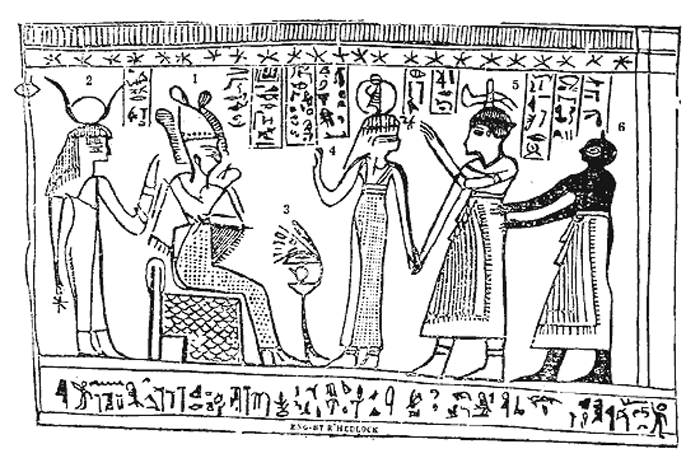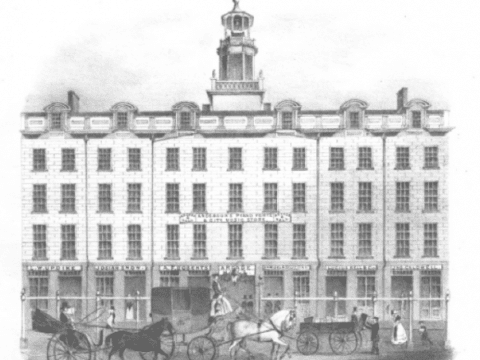
Latter-day Saints often use the verb “bear” with “testimony” when expressing their religious conviction, as in “I’d like to bear my testimony that I know that Jesus Christ lives and that the Gospel of Jesus Christ has been restored on the earth.” A sense of personal revelation through the Holy Ghost or spiritual experiences and evidence for one’s faith or reasons for belief are often associated with the “bearing of testimony.” Members of the Church are sometimes surprised to learn that the phrase “bear testimony,” though intelligible English that is sometimes used in a variety of secular contexts, is not commonly used in other faiths and is often viewed as a unique characteristic of the Latter-day Saint faith. For example, a recent search on Google of “bear testimony” showed six of the top ten results were from the Church website or websites about the Church, while the three videos shown were also all Church videos.
The concept of sharing one’s witness for Christ or the truthfulness of the scriptures, for example, is not unique to The Church of Jesus Christ of Latter-day Saints, but our preference for the term “bear testimony” as a statement of faith and even personal revelation does seem relatively peculiar to our religion. How did we come to use this phrase so heavily?
The term “bear testimony” does not occur in the Bible, though Revelation 1:2 speaks of John “who bare record of the word of God, and of the testimony of Jesus Christ, and of all things that he saw.” In the Greek, a single verb (μαρτυρέω, martyreō) translated as “bear record” applies to both “the word of God” and “the testimony of Jesus Christ,” so the KJV is not using a form of “bear testimony” per se.[1] For example, the New King James Version (NKJV) has “who bore witness to the word of God, and to the testimony of Jesus Christ, to all things that he saw,” indicating that John was bearing record to the testimony of Jesus. The KJV Bible has instances of those who “bare record” or “bare witness” (our modern verb “bear” is spelled “bare” in the KJV for both present and past simple tenses), but not “bear testimony” or related forms.
Our use of “bear testimony” may derive from the language used in the highly influential Testimony of the Three Witnesses, who, after describing their June 1829 experience regarding the gold plates that were shown unto them by an angel sent from God, state that they “bear testimony of these things.” The language in their declaration draws heavily upon language from the Book of Mormon, especially language from 2 Nephi. In fact, the passage in 2 Nephi that triggered the request of the Three Witnesses to serve as witnesses commands them to “bear testimony”:
Wherefore, at that day when the book shall be delivered unto the man of whom I have spoken, the book shall be hid from the eyes of the world, that the eyes of none shall behold it save it be that three witnesses shall behold it, by the power of God, besides him to whom the book shall be delivered; and they shall testify to the truth of the book and the things therein.
And there is none other which shall view it, save it be a few according to the will of God, to bear testimony of his word unto the children of men; for the Lord God hath said that the words of the faithful should speak as if it were from the dead. (2 Nephi 27: 12-13)
“Bear testimony” occurs elsewhere in the Book of Mormon. Mormon uses “bearing down in pure testimony” (Alma 4:19) in describing Alma2’s efforts to preach to the Nephites, an interesting variation of “bear testimony,” which he also uses:
And the office of their ministry is to call men unto repentance, and to fulfill and to do the work of the covenants of the Father, which he hath made unto the children of men, to prepare the way among the children of men, by declaring the word of Christ unto the chosen vessels of the Lord, that they may bear testimony of him. (Mormon 7: 31)
This phrase is also found in the Book of Moses: “And righteousness will I send down out of heaven; and truth will I send forth out of the earth, to bear testimony of mine Only Begotten” (Moses 7:62). Earlier in Moses 7, we also read of angels “bearing testimony of the Father and Son” (v. 27).
Since “bear testimony” was used in the crucial passage of 2 Nephi 27 that prophesied of the role of the Three Witnesses and prompted their quest to serve as witnesses, it is logical that the “bear testimony” in their statement came from the Book of Mormon language that was dictated by Joseph Smith. Why the Book of Mormon and Book of Moses use “bear testimony” instead of related phrases in the KJV such as “bear record” or “testify of” is not clear. After checking with a scholar of ancient languages, it seems that there is not any obvious expression in Hebrew of Egyptian that would clearly best be translated as “bear testimony” over alternative expressions. But while “bear testimony” seems odds to many outside Latter-day Saint circles and is not in the Bible, the phrase in a religious context can be found in writings from Joseph Smith’s day, and can also be found in many Early Modern English texts from 1500 AD onward. Its usage in the Early Modern English era (from roughly 1500 to 1790 AD) is interesting in light of the work of Stanford Carmack and Royal Skousen in noting the abundance of data showing that the language of the Book of Mormon as dictated by Joseph Smith is frequently infused with Early Modern English syntax not found or seldom found in the KJV era, including language characteristic of the decades before the KJV Bible was translated. “Bear testimony” seems to fit comfortably with their observations and the proposal that the revelatory translation process gave Joseph wording that was often not in his own dialect of English, but again, the use of “bear testimony” is also consistent with the hypothesis that Joseph’s environment, including exposure to religious writings and sermons, could have led him to choose use “bear testimony” as a translation choice.
The Relationship Between the Testimony of the Three Witnesses with the Writings of Nephi
Regardless of whose translation choice gave us “bear testimony” in the Book of Mormon and Book of Moses, the textual relationship between the the writings of Nephi (or the Book of Mormon in general) with the Testimony of the Three Witnesses suggests that their choice of language was strongly influenced by the Book of Mormon.
Note the allusions in the Testimony of the Three Witnesses to the words of Nephi, especially in chapters near the end of 2 Nephi:
|
Testimony of the Three Witnesses |
Nephi1’s Writings |
| Be it known unto all nations, kindreds, tongues, and people, |
And that he manifesteth himself unto all those who believe in him, by the power of the Holy Ghost; yea, unto every nation, kindred, tongue, and people, working mighty miracles, signs, and wonders, among the children of men according to their faith. (2 Nephi 26:13) |
|
unto whom this work shall come: That we, through the grace of God the Father, and our Lord Jesus Christ, have seen the plates which contain this record, which is a record of the people of Nephi, and also of the Lamanites, their brethren, and also of the people of Jared, who came from the tower of which hath been spoken. |
Wherefore, he will proceed to do a marvelous work and a wonder among the children of men. (2 Nephi 25: 17)
Therefore, I will proceed to do a marvelous work among this people, yea, a marvelous work and a wonder…. (2 Nephi 27:26) … at that day when I shall proceed to do a marvelous work among them, that I may remember my covenants which I have made unto the children of men, that I may set my hand again the second time to recover my people, which are of the house of Israel;… (2 Nephi 29:1) |
|
And we also know that they have been translated by the gift and power of God, for his voice hath declared it unto us; wherefore we know of a surety that the work is true.
|
… behold, these things shall be hid up, to come forth unto the Gentiles, by the gift and power of the Lamb. (1 Nephi 13: 35)
And his name shall be called after me; and it shall be after the name of his father. And he shall be like unto me; for the thing, which the Lord shall bring forth by his hand, by the power of the Lord shall bring my people unto salvation. (2 Nephi 3: 15) the power of God, and the gift of the Holy Ghost (2 Nephi 28:26) |
|
And we also testify that we have seen the engravings which are upon the plates; and they have been shown unto us by the power of God, and not of man. |
… the eyes of none shall behold it save it be that three witnesses shall behold it, by the power of God, besides him to whom the book shall be delivered…. (2 Nephi 27: 12) |
|
And we declare with words of soberness, that an angel of God came down from heaven, and he brought and laid before our eyes, that we beheld and saw the plates, and the engravings thereon; and we know that it is by the grace of God the Father, and our Lord Jesus Christ, that we beheld and bear record that these things are true. And it is marvelous in our eyes. Nevertheless, the voice of the Lord commanded us that we should bear record of it; wherefore, to be obedient unto the commandments of God, we bear testimony of these things. |
… and they shall testify to the truth of the book and the things therein.
And there is none other which shall view it, save it be a few according to the will of God, to bear testimony of his word unto the children of men.… (2 Nephi 27: 12–13) … a marvelous work…. (2 Nephi 25: 17, 27: 26, 29: 1) |
|
And we know that if we are faithful in Christ, we shall rid our garments of the blood of all men, and be found spotless before the judgment-seat of Christ, and shall dwell with him eternally in the heavens. |
Behold, I take off my garments, and I shake them before you; I pray the God of my salvation that he view me with his all-searching eye; wherefore, ye shall know at the last day, when all men shall be judged of their works, that the God of Israel did witness that I shook your iniquities from my soul, and that I stand with brightness before him, and am rid of your blood. (2 Nephi 9:44)
|
|
And the honor be to the Father, and to the Son, and to the Holy Ghost, which is one God. Amen. THE TESTIMONY OF EIGHT WITNESSES |
And now, behold, this is the doctrine of Christ, and the only and true doctrine of the Father, and of the Son, and of the Holy Ghost, which is one God, without end. Amen. (2 Nephi 31: 21) |
Given Nephi’s obvious desire to apply the law of witnesses to help establish the sacred record he was helping to create for the benefit of future generations, as Bruce Orden describes in “The Law of Witnesses in 2 Nephi,”[2] we can assume that Nephi would be delighted to see how his words not only catalyzed the monumental Testimony of the Three Witnesses, but strongly influenced the phrasing they would use to share their witness to the world.
The relationship of the Testimony of the Three Witnesses from late June 1829 suggests that the authors were familiar with the text of 2 Nephi up to at least 2 Nephi 31. This is consistent with timelines for the translation of the Book of Mormon from John W. Welch [3] and also from Eldon Watson.[4] Welch’s analysis identifies June 22, 1829 as the date for translation of 2 Nephi 28–31.[5] Then the final two chapters of 2 Nephi are shown as completed on June 23, when Welch adds, “About this time, the manifestation of Moroni was given to the Three Witnesses, as prompted by the translation of 2 Ne. 27:12–13.” [6] Then came followed by Jacob, Enos, Jarom, Omni, and the Words of Mormon translated from June 24 to June 28, 1829. [7]
“Bear testimony” was also used by Mormon, perhaps influenced by his reading of Nephi1’s writings. While it is widely assumed that the Words of Mormon were written at the end of Mormon’s translation work as an explanation for his addition of Nephi’s small plates to the end of his abridgement of the large plates, an important study by Clifford Jones provides significant evidence that the “our current Words of Mormon in the Book of Mormon was originally a second chapter of the book of Mosiah following an initial chapter that was part of the lost 116 pages.” [8] This breakthrough in understanding the Book of Mormon resolves several questions and contributes to the remarkable internal consistency in the text and in the plausibility of the account of its origins.
Recognizing the Words of Mormon was written before the abridgement of all the large plates text in our current Book of Mormon helps us appreciate the influence of the small plates more fully and the unity of the Book of Mormon message as crafted by Mormon with strong influence from the earliest writers of the Nephite records, and thus some of earlier writers’ close familiarity and emphasis on records from the brass plates may have led to Mormon’s further use of such material, including verbiage related to the Book of Moses.
Royal Skousen has also noted the relationship of the Testimony of the Three Witnesses to the text of the Book of Mormon, but argues that much of its language can be found scattered throughout the Book of Mormon rather than observing the concentration of language from 2 Nephi, especially in the final chapters. Skousen contends that its similarity to Book of Mormon language could mean that Joseph Smith was the author, which would be plausible if the Testimony’s language was similar to the text in general rather than with specific text near the verses that triggered the witnesses’ petition to serve in the role Nephi prophetically mentioned.[9] While some of the language highlighted in the table above can be found elsewhere in the Book of Mormon, the language near 2 Nephi 27 probably should be given priority in considering the default position that the witnesses, particularly Oliver Cowdery, drafted the text. The editors of the Joseph Smith Papers provide a footnote in presenting the Testimony of the Three Witnesses in Joseph Smith’s History:
The earliest copy of the testimony that follows is found in the printer’s manuscript of the Book of Mormon, in the handwriting of Oliver Cowdery. Cowdery likely was the author of the statement, given his writing abilities and similarities between the document and Cowdery’s 1829 correspondence to JS [Joseph Smith] and Hyrum Smith. The copies of the “Testimony of Three Witnesses” and the “Testimony of Eight Witnesses” that follow match the versions in the second edition of the Book of Mormon.[10]
Skousen, however, objects to the assumptions behind this conclusion:
This statement assumes, first of all, that Joseph himself did not have the writing ability to author the three-witness statement – or perhaps more importantly, it excludes the possibility that Joseph could have received the three-witness statement as a revealed text. In addition, there are these purported similarities with Cowdery’s letter writing in 1829 (when he was serving as scribe for Joseph Smith), but unfortunately there are no actual examples given of these similarities, nor is there any reference to some independent research that has been done on this issue.
In looking at the actual language of the three-witness statement, it becomes very clear that nearly every phrasal and clausal expression can be found within the Book of Mormon text itself. In fact, many are virtually identical. Moreover, the closest instances of similarity in usage are found throughout the text, not congregated in one section. Eight of the similarities come from two places in the text where the three witnesses are referred to (in 2 Nephi 27 and Ether 5). Yet the clear majority of similarities are found scattered throughout the text.[11]
There are strengths to his approach. For example, the statement about ridding garments of blood, while related to 2 Nephi 9:44, seems somewhat more directly related to the source Skousen favors, Mormon 9:35: “And these things are written that we may rid our garments of the blood of our brethren, who have dwindled in unbelief.” But again, Oliver Cowdery could have easily been familiar with this phrasing as a scribe. In another example, Skousen assigns translation “by the gift and power of God” to Omni 1:20 which refers to translation of engravings on a large stone by King Mosiah1, overlooking the words of Nephi regarding the coming forth of the Book of Mormon, stating that “these things shall be hid up, to come forth unto the Gentiles, by the gift and power of the Lamb” (1 Nephi 13:35). This is the only passage of Nephi’s writing in the table above that comes from 1 Nephi, but related passages occur in 2 Nephi. While Nephi’s writings could motivated the use of the “gift and power” of God in the Testimony, Omni as a source works well given that the drafting of the Testimony of the Three Witnesses may have occurred almost immediately after Omni was translated, even though the experience described may have happened a few days earlier.
References to general concepts such as the Lamanites, grace, etc. also seem less important that than the concepts directly related to the material in 2 Nephi, so it still seems most reasonable to consider the Testimony of the Witnesses to be a product of the witnesses that draws heavily upon what was recently translated material (possibly extending up to Omni). But regardless of who authored the Testimony of the Three Witnesses, it seems clear that this memorable and highly influential document draws heavily upon Book of Mormon language, including the term “bear testimony.”
I turned to a scholar familiar with several ancient languages and learned that there doesn’t seem to be anything in ancient Hebrew or Egyptian that would call specifically for a translation of “bear testimony” over other phrases such as “bear record,” “witness of,” testify of,” etc., so “bear testimony” in Latter-day Saint scriptures likely reflects a subjective translation choice made by or somehow given to Joseph Smith. That it is found in both the Book of Mormon and the Book of Moses is interesting, but may simply reflect consistent translation choices.
While our scriptures use a variety of terms for concepts related to bearing record of or providing a witness for something, the term “bear testimony” in 2 Nephi 27:13 may have motivated use of the term in the Testimony of the Three Witnesses, which in term helped fuel widespread use of that term in the Church. Those who, like the Three Witnesses, have experienced remarkable or even subtle events that build their faith or have encountered clear evidence for some aspect of their faith will also tend to speak of “bearing testimony” or “bearing their testimony” when they share their witness. When we hear such language, let’s recall the Testimony of Three Witnesses and the remarkable events behind that rise of that term in the Church.
Footnotes
[1] See the interlinear analysis of Revelation 1:2 in the Textus Receptus at Blue Letter Bible, https://www.blueletterbible.org/kjv/rev/1/2/t_conc_1168002. Also see Strong’s G3140, μαρτυρέω (martyreō), at https://www.blueletterbible.org/lexicon/g3140/kjv/tr/0-1/.
[2] Bruce A. Van Orden, “The Law of Witnesses in 2 Nephi,” in Second Nephi, The Doctrinal Structure, ed. Monte S. Nyman and Charles D. Tate Jr. (Provo, UT: Religious Studies Center, Brigham Young University, 1989), 307–21, https://rsc.byu.edu/book-mormon-second-nephi-doctrinal-structure/law-witnesses-2-nephi.
[3] John W. Welch, “Timing the Translation of the Book of Mormon: ‘Days [and Hours] Never to Be Forgotten,’” BYU Studies Quarterly 57, no. 4 (2018): 10–50, https://byustudies.byu.edu/article/timing-the-translation-of-the-book-of-mormon-days-and-hours-never-to-be-forgotten/.
[4] Eldon Watson, “Approximate Book of Mormon Translation Timeline,” April 1995; http://www.eldenwatson.net/BoM.htm, accessed April 16, 2023.
[5] Welch, “Timing the Translation of the Book of Mormon,” 48.
[6] Ibid.
[7] Ibid., 49.
[8] Clifford Jones, “That Which You Have Translated, Which You Have Retained,” Interpreter: A Journal of Latter-day Saint Faith and Scholarship 43 (2021): 1-64, https://journal.interpreterfoundation.org/that-which-you-have-translated-which-you-have-retained/.
[9] Royal Skousen, “Who Authored the Three-witness Statement?,” Times and Seasons (blog), June 1, 2012, http://archive.timesandseasons.org/2012/06/who-authored-the-three-witness-statement/.
[10] “History, circa June 1839–circa 1841 [Draft 2],” Joseph Smith Papers, fn 77, https://www.josephsmithpapers.org/paper-summary/history-circa-june-1839-circa-1841-draft-2/31#foot-notes.
[11] Skousen, “Who Authored the Three-witness Statement?”












Hello!
I really like your blog! my name is benedict and im 13. I’m not an LDS member but I’m establishing a personal faith/spirituality for myself (a spirituality for only me-I do not want to convert anyone) and I have been heavily influenced by the LDS Church. I want to become the priest of my new and personal religion and I was wondering if you could ordain me as the first priest of my religion/say a blessing for me. You can ordain me not as a priest of your religion, but as a bishop of my religion (I ask you to ordain me because I can’t ordain myself-I need someone else to ordain me). You can just ordain me by writing a comment/writing a blessing.